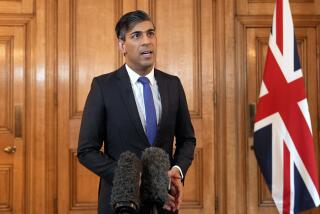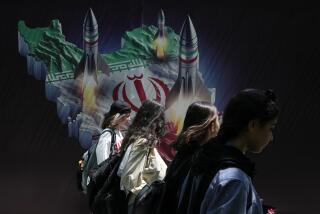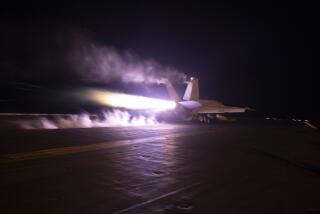French in 1st Iraq Air Strike; Allied Planes Step Up Attack : Gulf War: Mitterrand responds to criticism of half-hearted effort. U.S. troops free first chunk of Kuwait--a tiny ‘bird sanctuary’ island--but it gives emirate’s citizens a psychological boost.
RIYADH, Saudi Arabia — French warplanes screamed into Iraq for the first time Thursday in a stepped-up air assault on the elite Republican Guard, and allied troops liberated the first chunk of Kuwait--a tiny island in the Persian Gulf.
The decision to attack Iraq, made personally by French President Francois Mitterrand in reply to criticism that France was waging a half-hearted war, loosed Jaguar fighter-bombers against mechanized units of the Republican Guard. The guard took some of their heaviest pounding so far at allied hands.
“We are hitting them with all our assets,” said Army Lt. Col. Greg Pepin, the spokesman for American forces. U.S. pilots and military commanders said bombs and missiles inflicted heavy damage on the Republican Guard, the backbone of Iraqi military strength, but they could not provide casualty figures.
While the liberation of the island of Qaruh, 22 miles off the shore of Kuwait, had only limited military value, it was of great psychological significance to Kuwaitis. The island is so small that it has no permanent residents and is often under water. A Kuwaiti spokesman, Hasan Abdul-Aziz, called it “a bird sanctuary.”
But he added, “It is the first piece of land liberated from the Iraqis.”
Qaruh fell during a U.S. Navy assault that killed three Iraqis, sank an Iraqi minesweeper and took 51 Iraqis prisoner, military officials reported. They said another minesweeper tried to flee--and exploded and sank when it apparently hit a mine.
In the eighth day of the Persian Gulf War, there were these additional developments:
A U.S. Marine battery, heavily outnumbered and under nagging fire along the Kuwaiti border, struck back with a daring hit-and-run artillery raid--the latest in a series of conflicts sputtering along the Saudi border as the air war raged overhead.
A Saudi pilot shot down two Iraqi jet fighters, reportedly loaded with bombs and Exocet missiles and headed for the gulf, where American ships are stationed. It was the first report of an Iraqi attempt to enter Saudi airspace--and the first dogfight of the war to end in a double kill.
Marine Corps Maj. Gen. Martin L. Brandtner told reporters at the Pentagon that the United States does not plan “at this time” to use chemical weapons to retaliate against any Iraqi chemical attack on allied troops. But he was interrupted by Pentagon spokesman Pete Williams, who said America refuses to rule out a chemical counterattack.
The French decision to send planes into Iraq was announced in Paris, where Defense Minister Jean-Pierre Chevenement suggested over the weekend that French military operations might be limited to targets in Kuwait. Mitterrand’s conservative opponents responded that French fliers seemed to be waging a half-hearted war alongside their U.S. and British counterparts.
They accused Mitterrand of hedging his bets to limit damage to ties with the Arab world. France was Iraq’s principal Western arms supplier during the 1980s, when Iraq was at war with Iran.
Mitterrand called the criticism “insulting” and said Sunday: “Wait and see how things evolve before making pejorative judgments.” Then, on Thursday, his chief military spokesman, Gen. Raymond Germanos, announced that the French president had decided on a “new phase” in operations.
Jaguar fighter-bombers based in Saudi Arabia hit mechanized units of the Republican Guard in southern Iraq, Germanos said. In a simultaneous attack, he said, Jaguars struck Iraqi artillery positions in Kuwait under the cover of French Mirage 2000s. Another French spokesman, Col. Jacques Rolland, said the French planes came under significant antiaircraft fire, but all returned safely.
Republican Guard
The French attack on the Republican Guard came as the allies stepped up their assault on guard positions, dug in deeply in the desert. U.S. bomber pilots reported a panorama of devastation in the region of southern Iraq and northern Kuwait where Republican Guard units have undergone days of heavy aerial bombardment.
“There’s a lot of blown-up stuff on the ground up there right now,” said Maj. Bobby Jernigan, an F-16A pilot who led an air strike that targeted artillery concentrations, tanks and division headquarters of the elite military unit.
“You can see the spots where B-52s came through, because B-52s carry a lot of bombs, and there is a big, long swath of craters,” Jernigan said. “There are areas of the earth that are just blackened circles that are 500 feet by 200 or 300 feet. That is probably where some cluster bombs went off and covered an area.”
Asked how he thought the Republican Guard units were holding up, Jernigan said simply: “Badly. Badly. . . . Everywhere you see stuff that looks like it would be a lucrative target, it looks like it’s been hit.”
Capt. Jeff Gurney, another F-16 pilot who hit the units, described the Republican Guard as “a monstrously big army. Basically, when you hit the ground, you’re going to get the army someplace.”
Qaruh Island
The allied attack on Qaruh Island followed an assault on the two minesweepers, which were operating nearby in the gulf.
A Navy A-6 Intruder fired on the minesweepers, according to Col. Phil Lacombe, a U.S. military spokesman--and as one sank and the other exploded, a Navy helicopter moved in to pick up survivors.
Iraqis on the island fired on the helicopter, he said.
The helicopter fired back, Lacombe said, and the Iraqis on the island surrendered. Of the 51 prisoners taken, he said, 29 were from the island and 22 from the minesweepers. He said the three Iraqis killed in the action were on the island.
“I understand it’s a small island,” Lacombe said. “There’s a navigation beacon, and it’s used for some fishery purposes.”
Although Lacombe said he was not sure whether allied forces took possession of the island after it was cleared of Iraqis, the Kuwaitis declared it liberated.
Abdul-Aziz, the Kuwaiti spokesman, estimated its size at only about 18,000 square yards and said that nobody lived there permanently. He doubted that it has any permanent structures. “It is usually used as a stopping point for fishermen and swimmers,” he said. “People would go to the island, have some lunch and do some swimming.”
But, small and insignificant as it is, he said it is of major importance as the first bit of Kuwait taken away from the Iraqis.
“Even if it was one square meter,” he said, “it would be significant.”
In the latest conflict on the Saudi border, units from the 1st Marine Division’s Fox Battery crept to within a few miles of occupied Kuwait and lobbed 35 rounds of high explosives toward a suspected rocket battery.
The Marines sped away before the Iraqis could return fire.
Because Iraqi forces are armed with almost five times as many artillery pieces, and some of substantially longer range, U.S. forces rely on speed and stealth.
It was Fox Battery’s second such raid this week and followed a skirmish between U.S. Army troops and Iraqi forces Tuesday that killed two Iraqi soldiers, injured two U.S. soldiers and led to the capture of six other Iraqis.
“What we did was send a message to Saddam that if he sends over mail, we’ll return it marked ‘postage due,’ ” said Capt. Bruce Kowalski, commander of Fox Battery.
The flare-ups reflected a slowly rising level of tension along the border as hundreds of thousands of allied troops streamed into position for an expected ground assault into Kuwait. But there was no indication when such an assault might come.
U.S. military officials have said they want to further cripple supply routes and lines of communication from Baghdad to the Saudi border before launching any full-scale ground assault. To that end, planes bombed Basra in southeastern Iraq for a third straight day. Basra is the site of the command and control center for Iraqi forces occupying Kuwait.
At the Pentagon, Navy Capt. David Harrington told reporters that the bombing had not yet closed most of the roadways that the Iraqis were using to ferry supplies to the nearly 300,000 troops they had arrayed in Kuwait, north of the Saudi border.
Just below the border, units from the Marine 1st and 2nd Divisions were stretched across the desert in holding positions throughout eastern Saudi Arabia. The Army picked up the front farther to the west. If and when an order comes to attack, these troops will move into their final assault positions.
Roads and highways throughout the border zone were lined with incoming flatbeds, water carriers and fuel trucks--at one point stretching as far as the eye could see.
“In my 14 1/2 years in the military, I have never seen anything like this,” said Maj. Baxter Ennis of the Army’s 82nd Airborne Division. “It reminds me of that line from the movie ‘Patton’: ‘Compared to war, all other forms of human endeavor pale by comparison.’ ”
Air Action
For at least one American pilot over occupied Kuwait, it became absolutely clear that Gen. Patton was right.
The pilot’s F-16 was hit by enemy fire, U.S. military officials said. The flier, who was not immediately identified, ejected over the Persian Gulf. As his aircraft hit the water, an allied helicopter zeroed in on his position. It hovered overhead and picked him up.
The helicopter took him to the guided-missile frigate Nicholas, stationed in the area.
“Our last report,” said Pepin, the Army lieutenant colonel, “is that the pilot is in good condition.”
The crew of a British warplane reportedly did not fare so well.
The aircraft, a British Tornado GR-1 fighter-bomber, was lost at about the same time that the American F-16 was hit, late Wednesday. British sources in Riyadh told the Associated Press that its two crewmen were missing.
That raised to 10 the number of missing in action reported by the British so far in the war.
Americans missing in action stood at 13 and Italians at two. Kuwaitis listed one person as missing in action.
Allied warplanes, however, took a toll on the Iraqi air force, as well. They destroyed three bombers in confirmed hits at an Iraqi landing strip, U.S. officials said.
And, the officials said, Navy A-6 jets destroyed a tanker collecting intelligence off the Saudi coast, as well as an Iraqi Hovercraft close by.
In Baghdad, the Iraqi government broadcast more interviews with men it described as two captured American airmen and one Italian flier.
Poor reception on Baghdad Radio, monitored in Cyprus, made the broadcast barely audible, but the Americans identified themselves as Col. David William Eberly and Lt. Lawrence Randolph Blake, 26, a carrier pilot.
Their Iraqi interviewer, according to the AP, quoted Eberly as saying, “Many pilots are expressing their opposition to this war.”
There was no way of knowing whether the pilots were speaking under duress.
Peter Arnett of Cable News Network, the only Western reporter still being permitted by the Iraqis to broadcast from Baghdad, said in an account subject to Iraqi censorship that planes made three more bombing raids on the Iraqi capital.
Arnett said he did not know what targets were hit, but he said Iraqi officials took him on a two-hour tour of residential and business neighborhoods that they said were hit by allied bombs. He said he saw three private homes demolished by what residents said was a bomb attack last Tuesday.
Three residents of one home were hospitalized, Arnett said, but the occupants of the other two homes fled when they heard air raid alarms.
In northwest Baghdad, Arnett said, he saw a group of small shops partially demolished next to a crater 15 feet deep. Windows of a psychiatric hospital and a mosque were shattered, he said, but local people told him no one was hurt.
On the outskirts of northern Baghdad, Arnett said, Iraqi officials showed him a civil defense headquarters they said had taken two direct missile hits on Monday. The building was destroyed, he said, and the officials told him two guards were injured.
The facility, Arnett quoted the officials as saying, “had no military role” but to help Iraqis under attack.
Although his report was subject to deletions by Iraqi censors, Arnett said: “Nothing I am saying I am being told to report.”
Chemical Warfare
The word about America’s disinclination to use chemical weapons came at a Pentagon briefing, where Gen. Brandtner, deputy director of operations of the Joint Chiefs of Staff, told reporters that the United States does not intend “at this time” to use poison gas to retaliate against any Iraqi chemical attack on allied troops.
But before Brandtner could finish, he was interrupted by Williams, the Pentagon spokesman, who said that Defense Secretary Dick Cheney had repeatedly refused to rule out the use of chemical weapons.
“What the secretary . . . has said consistently,” Williams said, “is that if the Iraqis were to use chemical or biological weapons, the United States would respond in the strongest way.”
The Pentagon also said that U.S. officials have not detected any release of radiation from the two nuclear reactors at Tawaitha, east of Baghdad, that were destroyed by U.S. bombers early in the air war.
Kennedy reported from Riyadh and Murphy from Dhahran, Saudi Arabia. Also contributing to this story was Times staff writer John M. Broder in Washington. This report includes material from Pentagon combat pool reports that were reviewed by military censors.
ISLAND ASSAULT
Allied forces attacked Iraqi troops on a small island 22 miles off the coast of Kuwait, in response to ground fire from the island.
Three Iraqis were killed and 29 surrendered after the fight on Qaruh.
Another 22 from an incident involving three Iraqi minesweepers were taken prisoner. There were no U.S. casualties.
More to Read
Sign up for Essential California
The most important California stories and recommendations in your inbox every morning.
You may occasionally receive promotional content from the Los Angeles Times.










